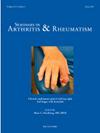在二级护理开始降低尿酸治疗的痛风患者中,护士主导的家庭血清尿酸监测的成本-效益:一项模型研究
IF 4.4
2区 医学
Q1 RHEUMATOLOGY
引用次数: 0
摘要
目的评估在二级医疗机构开始降尿酸治疗(ULT)的痛风患者中,由护士主导的家庭监测血清尿酸(SU)与常规护理的成本效益。此外,还评估了干预对护士和风湿病学家时间投入的影响。方法从社会角度进行成本-效果模型研究。家庭监测包括风湿病护士远程支持患者根据治疗到目标(T2T)调整ULT剂量,而患者在家中进行SU测试。常规护理包括以医院为基础的SU监测,并在T2T方法后进行风湿病专家访问。采用决策树(6个月)和马尔可夫模型(18个月)模拟两年的时间框架。费用包括药物、医疗服务时间、实验室/家庭测试费用、差旅费、生产力损失和痛风发作相关护理。以质量调整生命年(QALYs)衡量健康结果。成本效益通过概率敏感性分析确定,每个QALY的支付意愿阈值为20,000欧元。结果家庭监测证明具有成本效益,平均增量净货币效益(iNMB)为91.43欧元(可信区间(CI): -56.49至274.09)。QALYs从常规护理下的1.455 (CI: 1.389至1.517)轻微变化到两年家庭监测下的1.459 (CI: 1.391至1.523)。风湿病专家的时间减少了41分钟(CI: -116至11),尽管护士花费了额外的52分钟(CI: 4至143)。结论:该模型研究表明,与常规的二级痛风护理相比,护士主导的家庭监测开始ULT治疗的痛风患者血清尿酸水平可能具有成本效益。本文章由计算机程序翻译,如有差异,请以英文原文为准。
Cost-effectiveness of nurse-led home monitoring of serum urate for gout patients starting with urate-lowering therapy in secondary care: a modeling study
Objectives
To assess the cost-effectiveness of nurse-led home monitoring of serum urate (SU) versus usual care for gout patients starting urate-lowering therapy (ULT) in a secondary care setting. Additionally, the intervention's impact on nurse and rheumatologist time investment was evaluated.
Methods
A cost-effectiveness modeling study was conducted from a societal perspective. Home monitoring involved rheumatology nurses remotely supporting patients with ULT dose adjustments according to treat-to-target (T2T), while patients conducted SU testing at home. Usual care entailed hospital-based SU monitoring with rheumatologist visits also following the T2T approach. A decision tree (6‐month period) and a Markov model (18 months) were employed to simulate a two-year timeframe. Costs included medications, provider time, laboratory/home testing expenses, travel, productivity losses, and gout flare-related care. Health outcomes were measured in Quality-Adjusted Life Years (QALYs). Cost-effectiveness was determined via probabilistic sensitivity analyses using a €20,000 per QALY willingness-to-pay threshold.
Results
Home monitoring proved cost-effective, yielding a mean incremental net monetary benefit (iNMB) of €91.43 (credible interval (CI): -56.49 to 274.09). QALYs changed marginally from 1.455 (CI: 1.389 to 1.517) under usual care to 1.459 (CI: 1.391 to 1.523) with home monitoring over two years. Rheumatologist time was reduced by 41 min (CI: -116 to 11), though nurses spent an additional 52 min (CI: 4 to 143).
Conclusion
This modeling study demonstrates that nurse-led home monitoring of serum urate levels in gout patients starting ULT is likely to be cost-effective compared to usual secondary gout care.
求助全文
通过发布文献求助,成功后即可免费获取论文全文。
去求助
来源期刊
CiteScore
9.20
自引率
4.00%
发文量
176
审稿时长
46 days
期刊介绍:
Seminars in Arthritis and Rheumatism provides access to the highest-quality clinical, therapeutic and translational research about arthritis, rheumatology and musculoskeletal disorders that affect the joints and connective tissue. Each bimonthly issue includes articles giving you the latest diagnostic criteria, consensus statements, systematic reviews and meta-analyses as well as clinical and translational research studies. Read this journal for the latest groundbreaking research and to gain insights from scientists and clinicians on the management and treatment of musculoskeletal and autoimmune rheumatologic diseases. The journal is of interest to rheumatologists, orthopedic surgeons, internal medicine physicians, immunologists and specialists in bone and mineral metabolism.

 求助内容:
求助内容: 应助结果提醒方式:
应助结果提醒方式:


